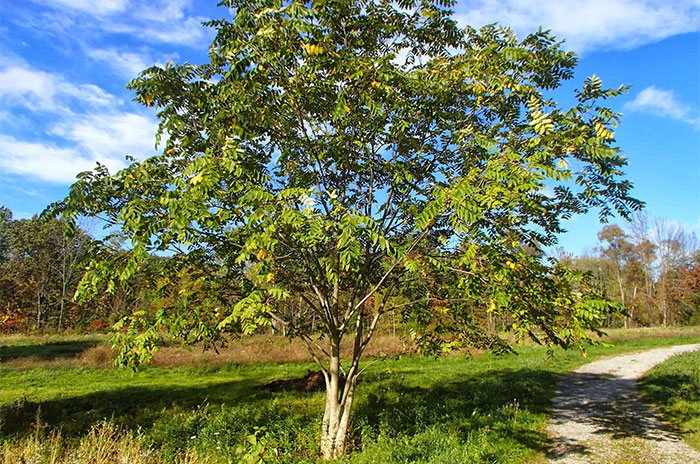Butternut Tree Symbolism Facts & Meaning: Zodiac, Superstitions, Dreams, and Myths
I
Butternut Tree Facts
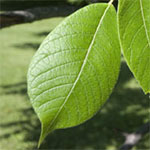
Also called as white walnut, the Butternut Tree is a native of North America. It grows in Eastern United States and Southeast Canada. However, it is one of the trees declared in 2008 to be at risk or endangered.
The Butternut Tree is a medium sized tree with a large crown of oval-pointed leaves. This tree is a species of the walnut tree and produces a cylindrical brown nut. The nuts mildly tastes like a walnut but the difference is that Butternut Tree has a creamy taste like the flavor of butter.
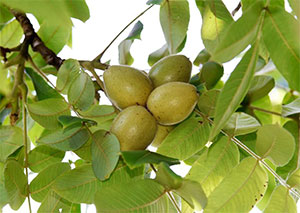
II
Butternut Tree Uses
For culinary uses, the nut is mixed to make bread and pudding. It acts as a natural sweetener and it adds a crunchy texture to the bread. The Butternut Tree is also used as flavoring because of its nutty and buttery flavor. Since it is oily, it has been used as a source for producing cooking oil. The sap of the Butternut Tree can also be a substitute for maple syrup.
The Butternut Tree has medicinal uses. The bark has been beneficial in treating toothaches, cure digestive problems, and clean wounds. The oil from the nut of the Butternut Tree was also used as hair conditioner and applied on the skin to repel mosquitos.
In the past, when there was enough supply of the Butternut Tree, the wood was sought after because of its strength and resistance to cracking. It was mainly appropriated for church altars, furniture, and millwork.

III
Butternut Tree History
The Butternet Tree grew originally in Eastern United States and Southeast Canada. It commonly grows in Quebec, Alabama, Minnesota, and Arkansas. It was first described in 1753 by Carl Linnaeus in his book Species Plantarum.
Sometime in 1845, George Washington Bush and his wife brought several trees from Minnesota to the Bush Prairie Farm in Tumwater, Washington. One of the trees they planted was the Butternut Tree. Said to be the oldest Butternut Tree in the world, the tree lived to 176 years old in May 2021 when it collapsed.
Due to a fungal disease called Butternut canker and gradual loss of habitat, the number of living Butternut Trees has declined over the years. It is declared as endangered in Canada, with less than 100,000 trees remaining.
IV
Butternut Tree Positive Symbolism
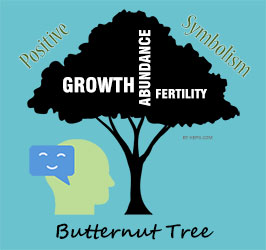
The Butternut Tree was a source for a lot of resources by the Native Americans. For this, it is considered as a symbol of fertility, abundance, and growth. Almost every part of the tree has a use especially the nuts and the bark.
The many uses of the Butternut Tree means that with hard work and resourcefulness, you can achieve abundance and prosperity. The growth of the nut, which is oval in shape, represents the womb and a good sign of pregnancy.
Like the walnut itself, the Butternut Tree has a connection with the Roman god Jupiter which represents intelligence, ambition, and discernment. Native Americans also associate it, as the walnut, with focus and clarity.
Scientifically, the nut of the Butternut Tree has medicinal benefits to the brain. In fact, the nut even looks like the human brain. This may explain why the Butternut Tree is highly regarded when it comes to success, goals, and decision-making.
V
Butternut Tree Negative Symbolism
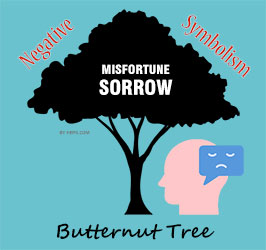
On the negative side, the Butternut Tree warns of misfortune and sorrow. While the tree symbolizes ambition and magnificence, it warns against being materialistic.
Being materialistic can cloud one person’s judgment which can in turn lead to misfortune. One should not focus too much on material prosperity because this will only lead to loss and sorrow.
VI
Butternut Tree Cultural Symbolism
The genus of the Butternut Tree is Juglans, which is derived from a Latin phrase that means “nut of Jupiter.” In some way, the Butternut Tree is related to Jupiter, who is the Roman god of sky and thunder.
In the same way, the Butternut Tree represents higher power. It symbolizes that you can also reach the sky and gain status with wisdom, focus, and hard work.
Native Americans believe that a person should be wise and well discerning like the Butternut Tree. Wisdom and clarity of mind is needed in making decisions in life. They also believe that the tree represents protection. It reflects the hard shell enclosing the nut. When facing difficulty, we must protect ourselves in our thinking and decisions of what should be done.
VII
Butternut Tree Zodiac Sign
The walnut tree, to which the Butternut Tree belongs to, is the Celtic zodiac sign for people who were born on April 21 to April 30 and October 22 to October 31.
The Butternut Tree is governed by the planet Sun and the star sign Leo. The main characteristics of the planet Sun are will power and ego. Similarly, people born under the Butternut Tree are brimming with ambition, endurance, and authority. These people are persistent and tough like the Butternut Tree. They are organized and well planned.
However, when things do not go their way, they find it difficult to adapt. Due to their focus and ambitiousness, people born under the Butternut Tree have trust issues. They see themselves as dominant and independent.
VIII
Butternut Tree in Dreams
In general, the Butternut Tree appearing in dreams means big changes in life. In preparation for this change, wisdom and focus are needed. This change can be a big success or misfortune. Either way, be wise and have clarity of mind in dealing with the situation.
If you are climbing a Butternut Tree in your dream, this means that you are working towards your goals or taking a risk.
Usually, the cutting of a tree in dreams is a sign of bad luck. However, cutting a Butternut Tree means hard labor and that you are fighting for yourself. Sitting under a Butternut Tree is a good sign of happiness and an assurance that you are protected.
IX
Butternut Tree Omens and Superstitions
In Greek customs, the Butternut Tree is associated with a lot of gods including Artemis and Diana. Dionysus represents fertility while Diana represents both children and fertility. It follows that the fruit of the Butternut Tree represents fertility because consuming the nuts increases likelihood of pregnancy and helps in childbirth.
During a wedding, the nut of the Butternut Tree are also scattered to wish the newlyweds fertility and for their wishes to come true.
X
Butternut Tree Mythology and Folklore

In Greek mythology, the Butternut Tree is dedicated to Carya who is also known as the Lady of the Nut Tree. According to the story, the Greek god Dionysus fell in love with Carya. Carya was then guarded by her sisters from having intercourse with Dionysus.
Dionysus drove away Carya’s sisters and they were turned to rock. At her death, Dionysus turned Carya into a walnut tree. A temenos or sanctuary was dedicated to Carya in Laconia and she was venerated together with Artemis. An image of Carya was also sculpted from a walnut tree and can be seen in the columns in Athens, Greece.

